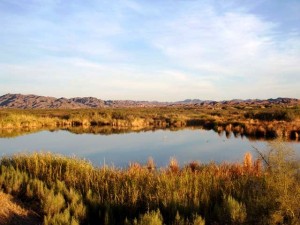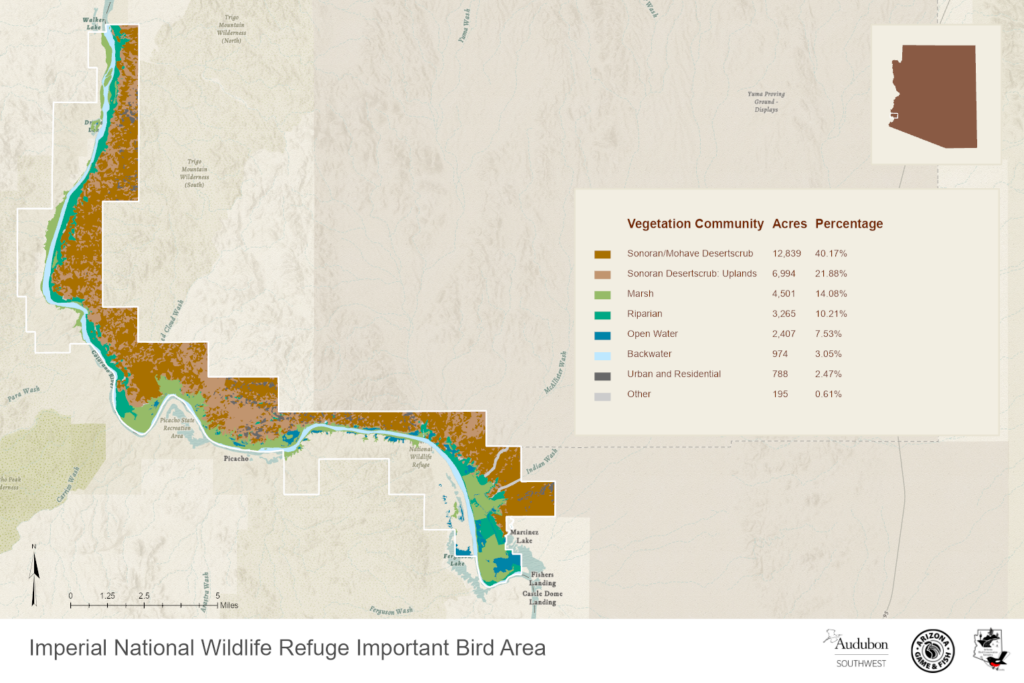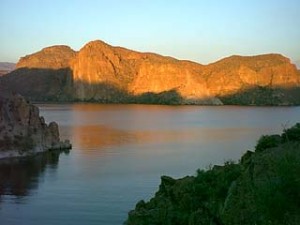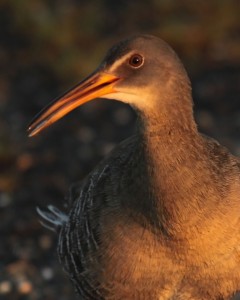Global IBA for Black Rail and Continental IBA for Yuma Ridgway’s Rail
Site Steward: Yuma Audubon Society
Size: 49.3 square miles, 31,558 acres
Identified: 06/2008
Visiting the IBA: From Yuma: Travel north on Highway 95. Near Milepost 47 turn left onto Martinez Lake Road. Follow Martinez Lake Road west for approximately 10 miles. Turn right onto Red Cloud Mine Road and follow signs directing you to the Visitor Center. Imperial National Wildlife Refuge – Arizona Birding Trail

Site Description: A 30-mile reach of the Colorado River bisects the refuge. Over 14,000 acres of the Refuge’s desert upland habitats are designated Wilderness area. Major resource initiatives on the refuge include restoration of native riparian habitats and wetlands to benefit migratory birds and other riparian-obligate species.
Birds: Spring and Fall offer the greatest variety of birds and the best birding opportunities. 275 species have been observed on the refuge. Also, the refuge is important as a wintering area for Canada geese and many species of ducks. Part of this IBA is within the Yuma Christmas Bird Count circle. Species of special conservation status and interest that use the habitats within this IBA include:
Year-round: Ladder-backed & Gila Woodpeckers, Phainopepla, Verdin, Crissal Thrasher, Abert’s Towhee.
Breeding: Yuma Ridgway’s (Clapper) Rail, California Black Rail, Sora, Least Bittern, Pied-billed Grebe, Clark’s & Western Grebes, Common Poorwill, Yellow-billed Cuckoo, Bell’s Vireo, Lucy’s Warbler (early spring), Yellow Warbler, Summer Tanager.
Migration: Sandhill Crane (rare, migration & winter), Willow Flycatcher.
Winter: Canada and White-fronted Geese, Tundra Swan (rare, winter), Peregrine & Prairie Falcons, Bald Eagle, Sage Sparrow.
Conservation Concerns: Historic loss of cottonwood and willow and marshlands habitats from the impacts of dikes, diversion canals and dams on natural hydrologic regime. Strategies: The Lower Colorado River Multi-Species Conservation Plan is implementing riparian forest restoration projects.
Maps of this Important Bird Area:
Mini Conservation Plan
Imperial-Cibola | Arizona Wildlife Conservation Strategy
Complete eBird.org Checklist of birds Reported for Imperial National Wildlife Refuge IBA
For an interactive map and habitat and land ownership analysis of this IBA visit the National Audubon IBA Map and select “Arizona” and then the name of this Important Bird Area. To access analysis graphs, click on the map boundary of the IBA.

Location: 32° 53’N, -114° 27’W
County: Yuma
Site Status: Identified 06/2008
Ownership: Federal and State
Area: 49.3 square miles, 31,558 acres
Criteria: A1 Global -Species of Conservation Concern – Black Rail (12 breeding pair – 2006)
B1 Continental – Species of Conservation Concern – Yuma Ridgway’s Rail (46 individuals – 2020)
D1 – Site Important to Special Status Avian Species – Federally listed Yuma Ridgway’s Rail and SGCN Black Rail
D3 – Rare, Unique, or Exceptional Representative Habitat/Ecological Community –Marsh and River Slough
D4i – Significant Concentrations of Birds, >1% State population: D4ii Waterfowl (2000+)
Site Description: The Imperial NWR lies within the Lower Colorado Subdivision of the Sonoran Desert, a region characterized by a scarcity of precipitation and high summer temperatures. A 30-mile reach of the Colorado River bisects the refuge. Over 14,000 acres of the Refuge’s desert upland habitats are designated Wilderness. Major resource initiatives on the refuge currently include restoration of native riparian habitats to benefit several declining populations of neotropical migratory birds and other riparian-obligate species, Colorado River native fish management, wetland restoration and moist soil management to benefit migratory bird species, development of baseline biological databases, and environmental education and public outreach.
| Vegetation Description | Hectares |
| ARROWEED – SCRUB COMMUNITIES | 246.9982 |
| CREOSOTEBUSH – BURSAGE (LOWER COLORADO R. VALLEY) COMMUNITIES | 197303.6 |
| LAKE | 193.2581 |
| MESQUITE BOSQUE COMMUNITIES | 9.799158 |
| MIXED PALOVERDE – CACTI COMMUNITIES | 88702.06 |
| NOT LABELED ON MANUSCRIPT | 13.37492 |
| REED COMMUNITES | 1589.163 |
| RIVER | 92.24459 |
| TAMARIX DISCLIMAX COMMUNITIES | 231.9967 |
Ornithological Summary:
Three Marshbird surveys have been established in 2008 as a part of the Multi-species Conservation Plan. A rapid survey is being conducted at the area which will be planted with cottonwood-willow land cover type, and adjacent habitat. The area which was planted was bare ground in the summer of 2007 and no birds were present, but the adjacent cottonwood nursery and a thin strip cottonwoods and willows planted on the west side were also surveyed as these areas will serve as sources for bird populations that will colonize the cottonwood-willow site, when planted. In these areas four LCR MSCP listed bird species were detected. These species were the: summer tanager (1 detected), yellow-billed cuckoo (Coccyzus americanus) (1 detected), Gila woodpecker (Melanerpes uropygialis) (1 detected), and yellow warbler (1 detected). (MSCP unpub. 2008 progress report-Chris Dodge).
Conservation Issues: Historic loss of cottonwood and willow and marshlands habitats from the impacts of dikes, diversion canals and dams on natural hydrologic regime. These losses are currently being mitigated through the LCR-MSCP. The Lower Colorado River Multi-Species Conservation Plan is implementing riparian forest restoration projects.










